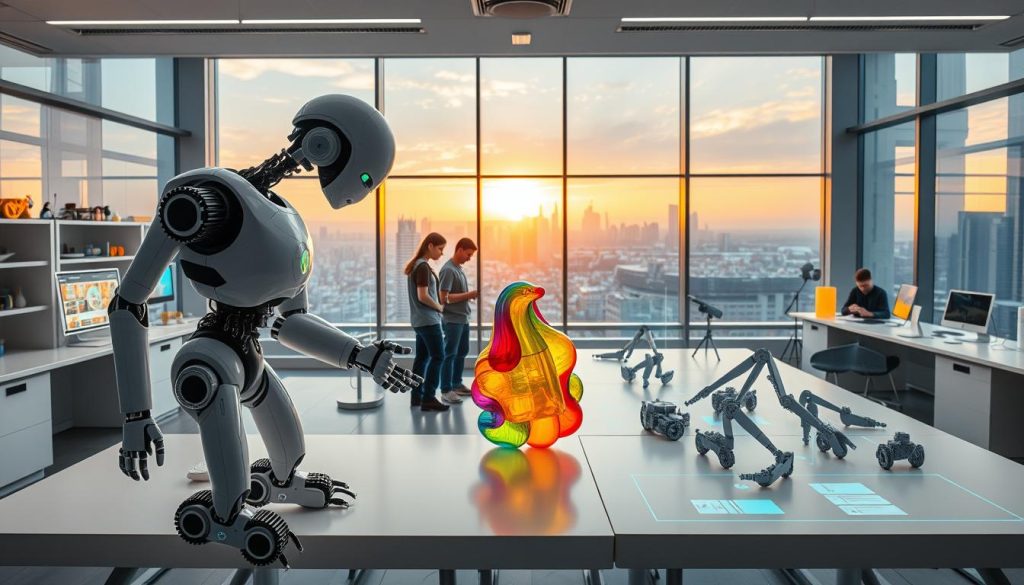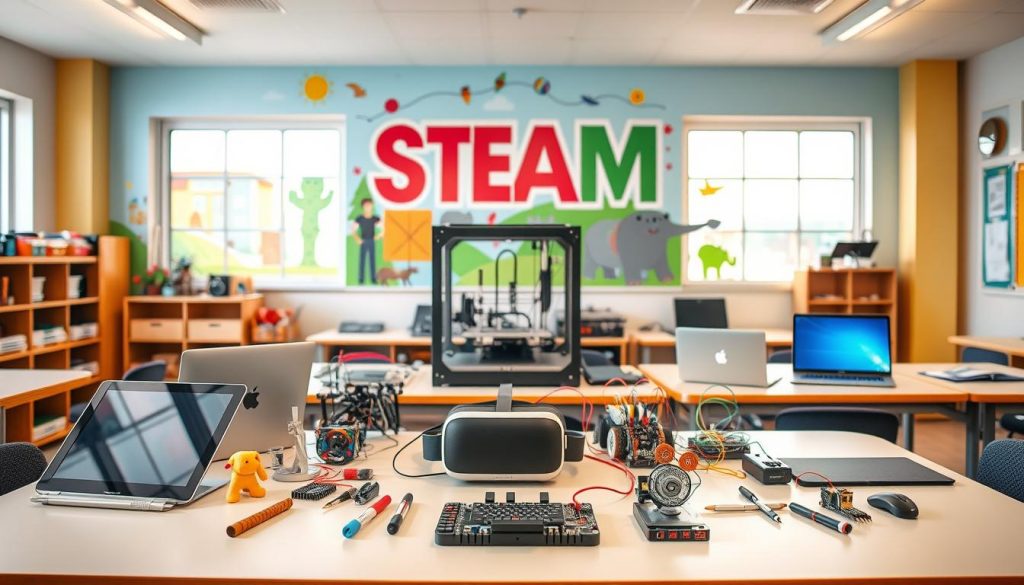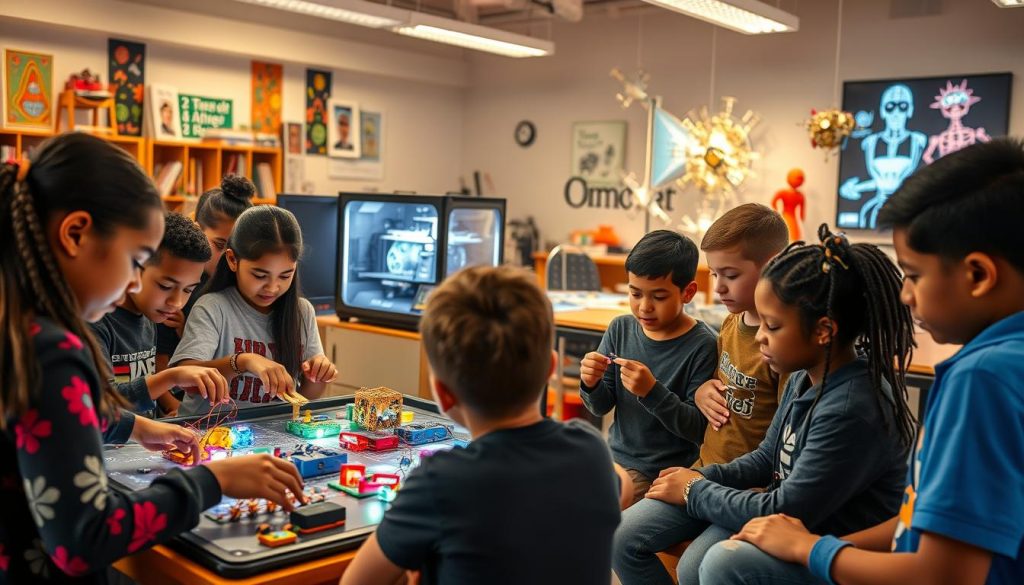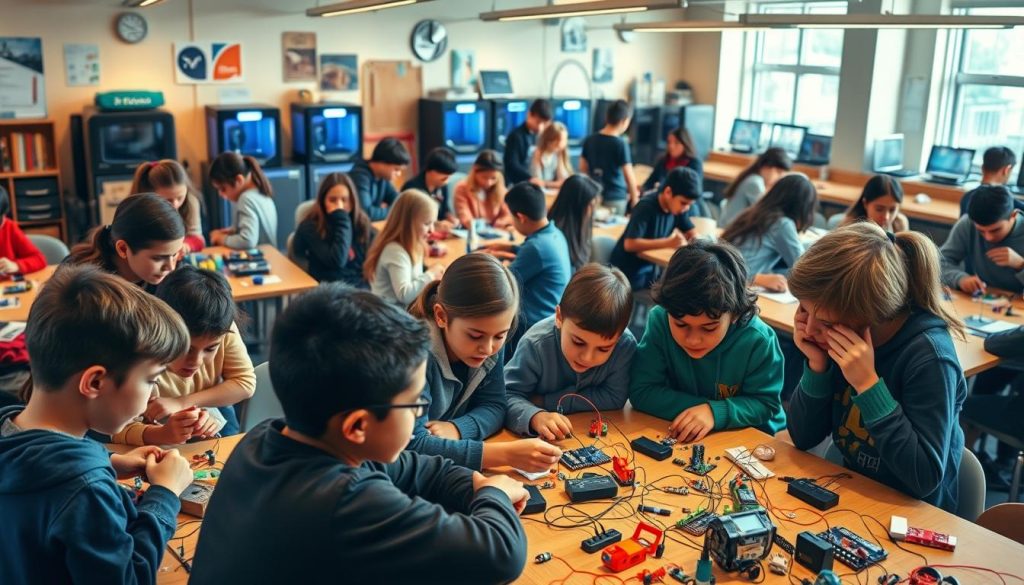Integrating STEM and arts in educational settings is revolutionizing the way students learn and interact with complex concepts. By combining these disciplines, educators can create a more engaging and holistic learning experience.
This approach not only fosters creativity but also enhances problem-solving skills and critical thinking. Cross-curricular activities play a pivotal role in this integration, allowing students to explore and understand the interconnectedness of different subjects.
The result is a more dynamic and inclusive classroom environment that caters to diverse learning styles and preferences. By embracing innovative projects, educators can inspire a love for learning that extends beyond the classroom.
Key Takeaways
- Integration of STEM and arts enhances student learning experiences.
- Cross-curricular activities promote holistic understanding.
- Innovative projects foster creativity and problem-solving skills.
- This approach caters to diverse learning styles and preferences.
- It results in a more dynamic and inclusive classroom environment.
The Power of Integrating STEM and Arts in Education
Combining STEM initiatives with arts initiatives in education encourages a more dynamic and inclusive approach to learning. This integration, often referred to as STEAM, is transforming the educational landscape by making it more interdisciplinary and holistic.
Why Cross-Curricular Learning Matters
Cross-curricular learning is essential because it mirrors real-world scenarios where problems are not confined to a single discipline. By integrating STEM initiatives with arts initiatives, students can develop a more comprehensive understanding of complex issues.
The STEAM Approach: Beyond Traditional Subject Boundaries
The STEAM approach goes beyond traditional subject boundaries by encouraging students to explore connections between seemingly disparate fields. This fosters interdisciplinary learning, where students apply scientific principles to artistic problems and vice versa.
Building 21st Century Skills Through Integration
By merging STEM with arts, students build critical 21st-century skills, including creativity, critical thinking, and collaboration. These skills are crucial for success in an increasingly complex and interconnected world.
Foundational Cross-Curricular Activities for Elementary Classrooms
Integrating STEM and arts in elementary education lays the foundation for a well-rounded learning experience. By combining these subjects, teachers can create engaging, interactive lessons that foster creativity, critical thinking, and problem-solving skills.
Nature-Inspired Art and Science Projects
Nature provides a wealth of inspiration for art and science projects. Students can collect leaves and create patterns, study the geometry of flowers, or observe the life cycle of butterflies. These activities encourage an appreciation for nature and introduce scientific concepts in an engaging way.
Mathematical Pattern Art Explorations
Mathematics and art are closely linked through patterns. Students can explore tessellations, create geometric art using shapes, or design patterns inspired by different cultures. This integration helps students understand mathematical concepts through a creative lens.
Simple Engineering Challenges with Artistic Components
Engineering challenges that incorporate artistic elements can make STEM subjects more appealing. For example, students can design bridges not only to test their strength but also to evaluate their aesthetic appeal. This approach teaches students about structural integrity while encouraging creativity.
Storytelling Through Digital Media
Digital storytelling is a powerful tool for integrating arts and STEM. Students can create animated stories, produce short films, or develop interactive presentations. This not only enhances their technical skills but also fosters creativity and self-expression.
| Project Type | Description | Skills Developed |
|---|---|---|
| Nature-Inspired Art | Creating art using natural materials | Observation, Creativity |
| Mathematical Pattern Art | Exploring geometric patterns and designs | Mathematical understanding, Artistic expression |
| Engineering Challenges | Designing and testing structures with artistic elements | Problem-solving, Critical thinking |
| Digital Storytelling | Creating interactive stories and presentations | Technical skills, Creativity |
Middle School Innovative Projects That Spark Curiosity
By introducing STEAM projects in middle school, educators can create an environment that encourages curiosity, creativity, and critical thinking. These projects not only make learning fun but also help students develop essential skills for the 21st century.
Interactive Sound and Music Science Experiments
Engaging students in interactive sound and music science experiments can be both entertaining and educational. For instance, creating homemade instruments or exploring the physics of sound waves can help students understand complex scientific concepts through hands-on experience.
- Experiment with tuning forks to demonstrate resonance
- Create a homemade guitar using everyday materials
- Explore the science behind sound waves and their applications
Architectural Design Challenges
Architectural design challenges encourage students to think creatively while applying mathematical and scientific principles. By designing and building models of structures, students learn about scale, proportion, and the importance of materials science.
Key activities include:
- Designing a bridge with specific load-bearing requirements
- Creating a model of a sustainable building
- Exploring historical architectural styles and their structural elements
Coding and Digital Art Integration
Integrating coding with digital art allows students to express their creativity while developing technical skills. Using coding platforms, students can generate art, animations, and even interactive stories.
Some popular coding tools for digital art include Scratch and Processing. These platforms enable students to bring their ideas to life through code.
Environmental Science Through Photography
Using photography as a tool for environmental science education can be highly effective. Students can capture images of their surroundings, documenting changes in nature and exploring ecological concepts.
- Documenting local wildlife and ecosystems
- Capturing the impact of human activity on the environment
- Creating a photo essay on a specific environmental issue
This approach not only teaches students about environmental science but also promotes awareness and stewardship of their local environment.
Advanced STEM & Arts Initiatives for High School Students

The integration of advanced STEM and arts initiatives in high school curricula is revolutionizing the way students learn and interact with complex concepts. By merging these disciplines, students are better equipped to tackle real-world challenges with creativity and innovation.
Robotics with Artistic Applications
Robotics combined with artistic elements allows high school students to explore the intersection of technology and creativity. Projects might include designing robotic sculptures or creating interactive installations that respond to environmental stimuli.
Data Visualization as Art
Data visualization transforms complex data into visually appealing and understandable graphics, making it an ideal intersection of STEM and arts. Students can learn to represent data through various artistic mediums, enhancing their analytical and creative skills.
“The most beautiful thing we can experience is the mysterious. It is the source of all true art and all science.” – Albert Einstein
Sustainable Design Projects
Sustainable design projects challenge students to create innovative solutions to environmental issues, combining STEM principles with artistic vision. Examples include designing eco-friendly buildings or developing sustainable product packaging.
| Project | STEM Component | Artistic Component |
|---|---|---|
| Sustainable Packaging | Material Science | Aesthetic Design |
| Eco-Friendly Buildings | Energy Efficiency | Architectural Design |
Interdisciplinary Research Exhibitions
Interdisciplinary research exhibitions encourage students to explore topics that combine multiple STEM and arts disciplines. By presenting their findings in an exhibition format, students develop their research, critical thinking, and presentation skills.
These advanced initiatives not only enhance students’ understanding of STEM and arts but also prepare them for future careers that increasingly value interdisciplinary approaches.
Project-Based Learning Strategies for Successful Implementation
The key to successful project-based learning lies in its thoughtful implementation, starting with well-defined learning objectives. Educators must consider several factors to ensure that project-based learning is both effective and engaging.
Establishing Clear Learning Objectives
Clear learning objectives are the foundation of any successful project-based learning initiative. These objectives should be specific, measurable, achievable, relevant, and time-bound (SMART). By establishing clear objectives, educators can ensure that students stay focused on the learning goals while working on their projects.
Creating Effective Project Timelines
Project timelines are crucial for keeping students on track and ensuring that projects are completed within the allotted timeframe. Educators should work with students to create realistic timelines that include milestones and deadlines. This helps students develop time management skills and allows educators to monitor progress effectively.
Balancing Structure and Creative Freedom
One of the challenges of project-based learning is striking the right balance between structure and creative freedom. Too much structure can stifle creativity, while too much freedom can lead to confusion. Educators should provide a framework that guides students while allowing them the flexibility to explore and express their ideas.
Assessment Techniques for Interdisciplinary Work
Assessing project-based learning can be complex due to its interdisciplinary nature. Educators should use a variety of assessment techniques, including rubrics, peer assessments, and self-assessments. These methods help evaluate not only the final product but also the process, including collaboration, critical thinking, and problem-solving skills.
| Strategy | Description | Benefits |
|---|---|---|
| Clear Learning Objectives | Establishing SMART goals for projects | Focuses student efforts, enhances learning outcomes |
| Effective Project Timelines | Creating realistic project schedules | Improves time management, monitors progress |
| Balancing Structure and Freedom | Providing a framework while allowing creativity | Encourages innovation, maintains direction |
Technology Tools That Enhance Cross-Curricular Activities

Technology tools play a crucial role in modern education, especially when it comes to innovative projects and cross-curricular activities. By integrating technology into the classroom, educators can create more engaging and interactive learning experiences that cater to a variety of learning styles.
Digital Creation Platforms for Classrooms
Digital creation platforms such as Adobe Creative Cloud and Tynker offer students a range of tools to express their creativity while developing technical skills. These platforms allow students to work on STEAM education projects that combine art, science, and technology.
Virtual and Augmented Reality Applications
Virtual and Augmented Reality (VR/AR) applications are transforming the way students learn by providing immersive experiences. Tools like Google Expeditions and zSpace enable students to explore complex concepts in a more engaging and interactive manner.
Collaborative Online Workspaces
Collaborative online workspaces such as Google Workspace and Microsoft Teams facilitate group projects and enhance cross-curricular activities. These platforms allow students to work together on documents, presentations, and projects in real-time, promoting teamwork and communication skills.
Accessible Tech Options for Various Budgets
Not all schools have the same budget for technology. Fortunately, there are many accessible tech options available, including free or low-cost tools like Canva for graphic design and OpenShot for video editing. These tools help ensure that all students have access to the technology they need to succeed in STEAM education.
| Technology Tool | Description | Cost |
|---|---|---|
| Adobe Creative Cloud | Comprehensive creative suite for graphic design, video editing, and more. | Subscription-based |
| Tynker | Coding platform for students to learn programming concepts. | Free and paid options |
| Google Expeditions | VR platform for immersive educational experiences. | Free |
Building Community Partnerships for Expanded Learning
To foster a more comprehensive education, schools are turning to community partnerships. These collaborations can significantly enhance learning opportunities by bringing real-world experiences into the classroom.
Connecting with Local Artists and STEM Professionals
Partnering with local artists and STEM professionals can provide students with unique insights and mentorship. For instance, artists can share their creative processes, while STEM professionals can offer practical applications of classroom concepts.
Benefits of Local Partnerships:
- Real-world learning experiences
- Networking opportunities for students
- Enhanced relevance of curriculum
Museum and Cultural Institution Collaborations
Museums and cultural institutions offer rich resources for interdisciplinary learning. By collaborating with these organizations, schools can provide students with hands-on experiences that combine STEM and arts education.
Industry Partnerships for Real-World Applications
Industry partnerships can help bridge the gap between classroom learning and real-world applications. This can be particularly beneficial for STEM education, where practical experience is invaluable.
| Industry | STEM Application | Arts Integration |
|---|---|---|
| Technology | Coding and software development | Digital art and design |
| Engineering | Mechanical and electrical engineering | Product design and visualization |
| Environmental Science | Conservation and sustainability | Environmental photography and documentation |
Virtual Expert Connections for Remote Areas
For schools in remote areas, virtual connections with experts can provide similar benefits to in-person partnerships. Video conferencing and online collaboration tools can facilitate these connections.
Virtual partnerships can offer flexibility and accessibility, making it possible for all students to benefit from expert insights and real-world experiences.
Addressing Equity and Inclusion Through Innovative Projects

By incorporating diverse perspectives into STEAM education, we can create a more inclusive learning environment. This approach not only enhances the educational experience but also prepares students for a diverse and globalized world.
Culturally Responsive STEAM Activities
Culturally responsive STEAM activities involve integrating students’ cultural backgrounds into the learning process. For example, using traditional art forms in geometry or incorporating cultural narratives into science projects.
Adapting Projects for Diverse Learning Needs
Adapting projects to cater to diverse learning needs is crucial. This can be achieved by providing multiple means of representation, expression, and engagement, as suggested by the Universal Design for Learning (UDL) framework.
Breaking Gender Stereotypes in STEM and Arts
Breaking gender stereotypes in STEM and arts requires intentional efforts. This can involve showcasing diverse role models, ensuring equal participation opportunities, and using inclusive language.
Multilingual Approaches to Project Instructions
Providing project instructions in multiple languages can help bridge the gap for linguistically diverse students. This approach ensures that all students have equal access to project information and instructions.
| Strategy | Benefit |
|---|---|
| Culturally Responsive Activities | Enhances engagement and relevance |
| Adapting for Diverse Needs | Increases accessibility |
| Breaking Gender Stereotypes | Promotes equality |
| Multilingual Instructions | Improves understanding |
In conclusion, addressing equity and inclusion through innovative projects is a multifaceted approach that requires careful planning and execution. By implementing culturally responsive activities, adapting projects for diverse needs, breaking gender stereotypes, and using multilingual instructions, educators can create a more inclusive and equitable learning environment.
Measuring Impact: Beyond Grades and Test Scores
The impact of interdisciplinary learning extends far beyond the confines of grades and test scores. As educators, it’s crucial to adopt a more holistic approach to evaluating student progress and the effectiveness of integrated STEM and arts programs.
Documenting Growth in Critical Thinking
One way to assess the impact of these programs is by documenting growth in critical thinking. This can be achieved through project evaluations, reflective journals, and self-assessment rubrics that measure a student’s ability to analyze information, solve complex problems, and think creatively.
Assessing Collaboration and Communication Skills
Collaboration and communication skills are essential outcomes of project-based learning. Assessing these skills involves evaluating how well students work together, share ideas, and present their findings to both peers and a broader audience.
Portfolio Approaches to Evaluation
Implementing portfolio approaches to evaluation allows students to showcase their work over time, demonstrating progress and mastery of various skills. This method provides a comprehensive view of a student’s capabilities and growth.
Long-Term Benefits of Interdisciplinary Learning
The long-term benefits of interdisciplinary learning include enhanced creativity, improved problem-solving skills, and better adaptability in an ever-changing world. These benefits position students for success in a wide range of future careers.
Conclusion: Transforming Education Through Creative Integration
Integrating STEM and arts through innovative projects and cross-curricular activities has the potential to transform education. By embracing STEAM education, educators can create engaging and effective learning environments that foster critical thinking, creativity, and collaboration.
The projects and strategies outlined in this article demonstrate the power of creative integration in classrooms. From foundational activities in elementary classrooms to advanced initiatives in high schools, STEAM education can be tailored to meet the needs of diverse learners.
By adopting innovative projects and cross-curricular activities, educators can help students develop essential skills for the 21st century. As education continues to evolve, the integration of STEM and arts will play a vital role in shaping the next generation of thinkers, creators, and problem-solvers.
FAQ
What are the benefits of integrating STEM and arts in education?
Integrating STEM and arts in education, also known as the STEAM approach, enhances student learning experiences by fostering creativity, critical thinking, and problem-solving skills. It prepares students for future careers by providing a more holistic understanding of subjects.
How can I implement project-based learning in my classroom?
To implement project-based learning, start by establishing clear learning objectives that align with your curriculum. Create effective project timelines, balance structure with creative freedom, and use assessment techniques suitable for interdisciplinary work, such as evaluating student portfolios.
What are some examples of cross-curricular activities for elementary classrooms?
Examples include nature-inspired art and science projects, mathematical pattern art explorations, simple engineering challenges with artistic components, and storytelling through digital media. These activities promote hands-on learning and encourage students to explore different subjects in an integrated manner.
How can technology enhance cross-curricular activities?
Technology tools such as digital creation platforms, virtual and augmented reality applications, and collaborative online workspaces can enhance cross-curricular activities by providing innovative ways to engage students and facilitate learning. These tools can also make learning more accessible and fun.
What strategies can help address equity and inclusion in STEAM education?
Strategies to address equity and inclusion include developing culturally responsive STEAM activities, adapting projects for diverse learning needs, breaking gender stereotypes in STEM and arts, and using multilingual approaches to project instructions. These strategies help ensure that all students have equal opportunities to benefit from STEAM education.
How can I assess the impact of integrated STEM and arts education beyond traditional grades?
Assessing the impact can be done by documenting growth in critical thinking, evaluating collaboration and communication skills, using portfolio approaches to evaluation, and considering the long-term benefits of interdisciplinary learning. These methods provide a more comprehensive understanding of student learning and development.
What are some advanced STEM & arts initiatives suitable for high school students?
Advanced initiatives include robotics with artistic applications, data visualization as art, sustainable design projects, and interdisciplinary research exhibitions. These projects challenge students and prepare them for future careers by integrating STEM and arts in complex and meaningful ways.




